By Nick Rinard MPT, Cert MDT
20 Apr, 2017
Physical Therapy Tips
bone, Cert. MDT, false positive, findings, imaging, joint, MRI, Nick Rinard MSPT, roles, x-ray
 “Should I get an x-ray or MRI before physical therapy?” This is a common question, and the answer is – NO. Why not? I hope to clarify that in this article, and give you a convincing reason to try physical therapy first.
“Should I get an x-ray or MRI before physical therapy?” This is a common question, and the answer is – NO. Why not? I hope to clarify that in this article, and give you a convincing reason to try physical therapy first.
First, physical therapists can make an accurate clinical diagnosis that will most likely match the radiological diagnosis. A 2005 study published in the Journal of Orthopedic and Sports Physical Therapy compared the agreement between what the physical therapist thought the imaging would show, and what doctors thought the imaging would show. “Clinical Diagnostic Accuracy and Magnetic Resonance Imaging of Patients Referred by Physical Therapists, Orthopedic Surgeons, and Non-orthopedic providers.” Physical therapists could predict the correct imaging diagnosis 74.5% of the time! That’s almost as accurate as orthopedic surgeons, and over twice as good as general practitioners!
- Physical Therapists = 74.5% (108/145)
- Orthopedic Surgeons = 80.8% (139/172)
- Non-orthopedic = 35.4% (86/243)
So, only in a small number of cases, will you need an x-ray or MRI to help determine your condition if it cannot be determined clinically.
False positives
Second, there are a lot of “false positive” findings associated with imaging. A false positive is when the test (radiologic image) shows you have the disease or condition, when you actually don’t. Some of you readers may know of people who were freaked out by a “finding” on their mammogram that turned out (luckily) to not be cancer. How often does this happen in the joints or spine that a physical therapist treats? If you are talking about the neck, quite a lot of people with NO NECK PAIN have a “major finding” on MRI. It is broken down below. (From The Journal of Bone and Joint Surgery 1990 “Abnormal magnetic-resonance scans of the cervical spine in asymptomatic subjects. A prospective investigation”)
For people less than 40 years old:
- Major abnormality in 14%
- Herniated disc = 10% (of subjects)
- Foraminal stenosis = 4%
- No “major” bulging discs were seen
- Narrowed disc space / degenerated discs = 25%
- Cord abnormalities = 9%
For people older than 40 years:
- Major abnormality in 28%
- Herniated disc = 5%
- Foraminal stenosis = 20%
- Only 1 subject “major” bulging disc was seen
- Narrowed disc space / degenerated discs = 57%
- Cord abnormalities = 1%
Remember, these are findings in people with NO NECK PAIN. If you have neck pain, there is a good chance that you might have one of these findings, but it would not be the source of your pain. The study authors conclude: “The prevalence of cervical spine pathology in asymptomatic (pain free) individuals of a wide-range of ages, points out the danger in ordering surgery or invasive procedures, or even giving the patient an ominous-sounding diagnosis, without first correlating these MRI findings with clinical signs and symptoms.”
Imaging the lumbar spine can also lead to errors as there is even greater incidence of false positive MRI findings in asymptomatic subjects in the lower back as compared to the neck…
“Abnormal magnetic-resonance scans of the lumbar spine in asymptomatic subjects. A prospective investigation.” J Bone Joint Surg Am. 1990
- 33% had a “substantial” abnormality
60 years old:
- 36% had a disc herniation
- 21% had spinal stenosis
Accurate Diagnosis with your Physical Therapist
If you are still reading this article, then you must be interested in getting an accurate diagnosis of your problem, and you might think a physical therapist could be the one person who can do that. You would be right. Plus, a physical therapist will offer you treatment for your condition, not surgery or drugs. I have been convinced beyond a doubt in my 20 plus years of practice that one should start with a good physical therapy evaluation and possibly treatment before turning to x-ray or MRI. A good physical therapist knows when the clinical diagnosis is complete and correct and when imaging is needed to help fill in the blanks. Don’t get an x-ray or MRI first. It might point you in the wrong direction and bias the clinician trying to arrive at the correct diagnosis and treatment. If you truly need imaging, your physical therapist at Nick Rinard Physical Therapy can help guide you in that decision.
More
 The American Heart Association recommends at least 30 minutes of moderate-intensity aerobic activity at least 5 days/week. In the pursuit of good health and fitness, many people are using YouTube to access new workouts. Unfortunately, there is neither quality control nor an accreditation process to ensure that the workouts are sound. Further complicating things is the “no pain, no gain” exercise myth which leads people to expect suffering with exercise. If someone expects exercising to be painful, they may not heed the early warning signs of pain and become injured.
The American Heart Association recommends at least 30 minutes of moderate-intensity aerobic activity at least 5 days/week. In the pursuit of good health and fitness, many people are using YouTube to access new workouts. Unfortunately, there is neither quality control nor an accreditation process to ensure that the workouts are sound. Further complicating things is the “no pain, no gain” exercise myth which leads people to expect suffering with exercise. If someone expects exercising to be painful, they may not heed the early warning signs of pain and become injured.
Recently, I treated a young woman who developed severe lower back pain after exercising with a popular fitness program online. She continued to push herself through the routines but after 2 weeks she quit exercising entirely. She was frustrated because her efforts to improve her health had actually worsened her condition. Her back pain was interrupting her sleep and limiting her ability to concentrate at work.
After just 4 sessions at Nick Rinard Physical Therapy she was pain free and equipped with an effective, individualized exercise program that supported her fitness goals without compromising her If your workout is wearing you down, we can help you get on the right track! Don’t settle for suffering through your exercise routine when you could be thriving.
More
By Margo Burette, DPT
08 Aug, 2016
Posture
assessment, cervical spine, chin, common, contact, posture, power, stresses, Toy poodle

What do a toy poodle and the human head have in common? They both share an average weight of 10-12 pounds. Your spine has three natural shock-absorbing curves which attenuate the stress of bearing that load above your shoulders while you move through your day. With good posture and frequent position changes, most of us can bear that weight without difficulty.
However, the moment you drop your chin to read the latest blog update on your cell phone the balance changes completely. When your head inclines forward 60 degrees the force your neck is bearing is equivalent to exchanging that toy poodle for a Labrador retriever – 60 pounds of force (Hansraj, 2014)! Consider that the average person sustains this position for 2-4 hours a day while using their smart phone and the load quickly becomes overwhelming. This chronic fatigue to the muscles and structure of the neck can lead to debilitating injury.
Your neck will thank you for contacting Nick Rinard Physical Therapy to address your posture.
Let us help you get that heavy Labrador off your shoulders!
Hansraj, KK. “Assessment of stresses in the cervical spine caused by posture and position of the head.” Surgical Technology International. 2014, November; 25:277-9
More
By Megan Plante, DPT
07 Apr, 2016
Physical Therapy Tips
age, aging, balance, challenge, dynamic, exercises, general, knowledge, Physical Therapy, practice, static
It is general knowledge that, as we age, our sensory systems start to decline. This includes sight, smell, temperature regulation and balance mechanisms. It’s important to have good balance because if it declines, you are at a higher risk for falling. And falling, results in injuries that can greatly affect your life.
Exercises that Challenge your Balance
What many people don’t know, is that you can work on making your balance stronger, just like you do a muscle: by exercising it! What physical therapy aims to do, is find exercises that challenge your balance system, so that your body must learn to adapt to certain situations and re-train itself on what to do.
Static and Dynamic Exercises
Physical Therapists can provide both static and dynamic exercises for you, depending on what is most challenging. Exercises can be very simple and integrated during daily routines- like balancing on one leg while brushing your teeth.
If you are having trouble with your balance, come in to Nick Rinard Physical Therapy and have an assessment by a physical therapist! 503-244-6232
More
By Megan Plante, DPT
29 Aug, 2014
Physical Therapy Tips
car accident, debate, education, healing, MVA, Physical Therapy, rest, ROM, training
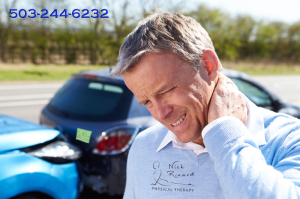 This is a question that seems to be in debate. At our clinic, we advise our patients to come in for treatment as soon as possible when experiencing pain in order for the fastest results. I have experienced push-back from other health care practioners who want the person to “rest” for 4-6 weeks before starting therapy. The problem with this? There are many things a person can be doing immediately after the MVA to facilitate healing and prevent dysfunction. All too often, we see people 6 months or longer after the MVA. If the patient has not been given anything to work on for exercises at home, the picture is this: limited, painful movement of the spine or joint, global weakness, and poor posture that becomes painful if corrected.
This is a question that seems to be in debate. At our clinic, we advise our patients to come in for treatment as soon as possible when experiencing pain in order for the fastest results. I have experienced push-back from other health care practioners who want the person to “rest” for 4-6 weeks before starting therapy. The problem with this? There are many things a person can be doing immediately after the MVA to facilitate healing and prevent dysfunction. All too often, we see people 6 months or longer after the MVA. If the patient has not been given anything to work on for exercises at home, the picture is this: limited, painful movement of the spine or joint, global weakness, and poor posture that becomes painful if corrected.
What does therapy look like in the first few weeks after an MVA?
- Initiate gentle range of motion exercise to prevent loss of movement
- Manual techniques including passive range of motion and soft tissue mobilization to promote blood flow and healing.
- Ultrasound modalities that decrease inflammation/swelling and promote tissue healing</li class=”rinardptli”>
- Education and training on how to prevent dysfunction
Here at Nick Rinard Physical Therapy, we see a lot of patients who have suffered an MVA. In fact, we see it so much we have a protocol for it that is very successful for treatment. Don’t wait! Start healing and feeling better today!
More
By Megan Plante, DPT
02 Jul, 2014
Physical Therapy Tips
core, deep muscles, endurance, factors, muscles, neuromuscular, proprioceptors, stability, strength, transverse adbominus
Core Stability : Definition
Core stability is a base or platform of musculoskeletal strength that results in control of the trunk and allows optimal performance of limb activity.
Deficits in core stability are found with people who have low back, knee or hip pain. It is important to know which muscles need to be targeted and when the right time to introduce strengthening should occur. Core strengthening should not be performed through pain in the lumbar spine.
Factors for core stability:
- Strength
- Endurance
- Proprioceptive awareness (sense of self in space when moving)
- Neuromuscular control
Possible core muscles that may need targeting:
- Transverse Abdominus (deep abdominals)
- Internal and External Obliques
- Lumbar Multifidus (spine muscles)
- Quadratus Labroum
- Rectus Femoris (one of the quadriceps muscles)
- Gluteus Maximus
- Gluteus Medius (hip and pelvis stabilizer)
Different muscles produce different torques on the pelvis which then produces either flexion or extension of the lumbar spine. Therefore, it is always important to consider a person’s directional preference while targeting the correct muscles that should either be strengthened or stretched.
Which muscles are the most important?
- None and all of them!
- No one muscle contributed more than 30% of the overall stability of the lumbar spine. Stability is dependent on all muscles
- The contributions of each muscle continually change throughout a task
- Need to train the muscles in multiple planes of movement to be more functional
- Don’t just strengthen abdominals: target the entire core!
Role of trunk muscles in stabilization
- Deep abdominals and lumbar multifidus activate prior to limb movement. This is reversed in people with Lower Back Pain (LBP).
- Athletes who experience an injury tend to have lower core stability measure than those who did not.
- Don’t just focus on strength. DO focus on recruitment and endurance as well. Need all 3 to work!
A Time and a Place
It is important to remember that core strengthening is not the best treatment for low back pain. Research continues to grow in support of Mechanical Diagnosis and Therapy and the utilization of the directional preference. However there is a time and place for core strengthening. A trained physical therapist can guide you through the necessary steps in order to decrease your pain and improve your life!
More
Osteoporosis is the leading cause of fractures resulting in billions of dollars being spent in the healthcare system. As a physical therapist, it is important to educate the public on information for reducing the risk of fracture, which is a frequent and possibly serious co-morbidity of osteoporosis. The public is subjected to multiple commercials advertising medications that can help fight osteoporosis. What they may not know, is that simple exercise alone can improve your bone density, decrease your risk of fractures and doesn’t come attached to a list of adverse side effects.
Facts:
- Osteoporosis is a bone disease that leads to decreased mineral content and bone density, resulting in a weakening of the bone
- The incidence of this disease has been shown to increase with older age
- Worldwide, 50% of women over the age of 60 will have an osteoporotic fracture, an incidence rate that is larger than the combined incident rates of heart attack, stroke, and breast cancer.
- One study from 1992 had a worldwide projection that osteoporotic fractures would affect one-third of all men during their lifetime by the year 2050.
- Primary risk factors for osteoporotic fractures include low bone mineral density, deterioration of bone, older age, Caucasian race, female sex, lower body weight and AN INACTIVE LIFESTYLE.
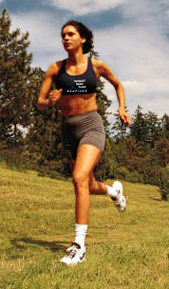 What can you do?
What can you do?
- Exercise can decrease the risk of an osteoporosis related fracture by 50%
- One study found that weight bearing exercise for 20 minutes a day can positively affect risk factors associated with osteoporotic fractures among elderly women. The exercises for the intervention group included: jumping, dancing, walking, strengthening, and balance exercises. The exercise group had increased leg strength as well as improvement in walking speed and endurance, as compared to the control group. In a long-term follow-up study, the same authors found that the above intervention decreased mortality in women with osteopenia (a precursor to Osteoporosis).
- A bi-weekly exercise routine developed by your PT can increase your bone density.
- Muscle contraction and mechanical loading deform bone and stimulate activity of osteoblasts, the cells which build bone.It is, therefore, not surprising that these interventions improve bone mineral density.
Want to learn more?
More
By Nick Rinard MPT, Cert MDT
07 Mar, 2014
Clinical Case of the Week, Exercise, Physical Therapy Tips
abolished, cervical, MDT, neck pain, shoulder, sugery, true cause of pain
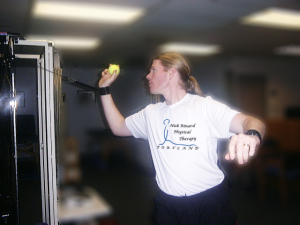 Very interesting clinical presentation today! The patient had been treated for neck pain here (Nick Rinard Physical Therapy) in the past with good results. Later, she developed shoulder pain and consulted her MD, who referred her to an orthopedic surgeon. There were “findings” on MRI and she ended up getting arthroscopic surgery. She returned to us for physical therapy to rehabilitate after surgery.
Very interesting clinical presentation today! The patient had been treated for neck pain here (Nick Rinard Physical Therapy) in the past with good results. Later, she developed shoulder pain and consulted her MD, who referred her to an orthopedic surgeon. There were “findings” on MRI and she ended up getting arthroscopic surgery. She returned to us for physical therapy to rehabilitate after surgery.
No Surgery Needed
Interestingly, she reported that her surgeon was surprised that her rotator cuff tendons were in “good condition” and did not require a repair – he had noticed that during the surgery procedure itself, apparently. So, physical therapy should be easy in such cases, right? No big surgical repair to worry about.
However, 6 weeks after the operation, her shoulder pain was not subsiding as it should have. Inflammation normally resolves in that amount of time and she should have been strong enough to resume normal office work duties consisting of keyboard and filing.
Finding the True Cause of the Pain
We had to take a closer look at her neck. It turned out that her neck was referring pain to the shoulder! In one neck treatment, the shoulder pain was abolished! The patient probably had had a recurrence of her old neck problem, it referred pain to her shoulder, and neither she, her MD, nor the orthopedic surgeon considered the true cause of the pain…
This is a frequent occurrence here at Nick Rinard Physical Therapy, where we use the Mechanical Diagnosis and Therapy (MDT) system of evaluation and treatment. Robin McKenzie started this method and it is the best method – and most supported by research – at getting to the true cause of pain.
Save time, money, and maybe avoid surgery!
If you or someone you know is having any problems that could be mechanical, a thorough mechanical assessment should be performed. In as little as one visit the problem might be identified and solved, saving a lot of time, money, and suffering! Plus, the patient might avoid unnecessary surgery!
More
By Nick Rinard Physical Therapy
14 Feb, 2014
Physical Therapy Tips, Posture, RinardPT Newsletters
chocolate, devoted, injured, Nick Rinard physical therapy, recipe, suffering, Teaching, Valentines Day
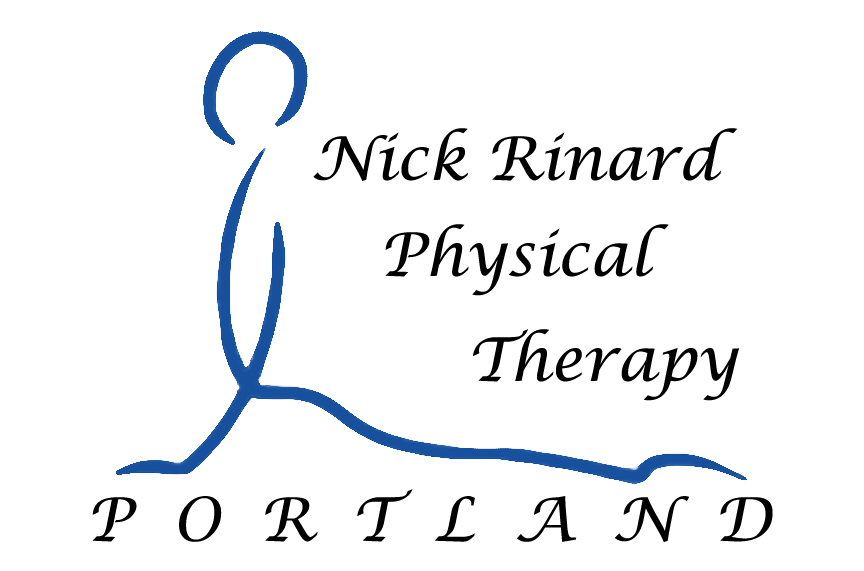 |
RinardPT Monthly
|
Nick Rinard Physical Therapy
9700 SW Capitol Hwy Suite 140
Portland, OR 97219
Volume 6, Issue 1
February 2014
|
Teaching YOU how to Get RESULTS
since 1999
Dear Friends,
It’s been 15 years since Nick Rinard devoted a physical therapy clinic to practicing Mechanical Diagnosis & Therapy. In that time, we have helped so many of you get back to a pain-free life. We’ve received pictures of our patients doing their exercises in all corners of the world, and are so proud of being part of your journey. THANK YOU for giving us all at MDT Physical Therapy the pleasure of teaching you how to get RESULTS!
Are you currently suffering from pain or injury?
Call 503-244-6232 today!
RinardPT patients get Results:
Don’t take our word for it
“I have been cutting hair for 46 years, and I have been experiencing pain in my right shoulder for at least 3 years. The pain has been getting worse and limiting movement & my ability to cut hair. 2 weeks ago the pain diminished to the point I could forget about it. I believe this was due to a new set of exercises designed by Megan and am very pleased with my progress. ”
-Curtis 01/21/2014 |
“Initially my pain level in my right let was a 10. On my very first visit the pain subsided significantly-to the point that I believed there was some magic happening! I would never imagined that 2 simple exercises would bring me to a pain level of zero. The ongoing preventative exercises are part of my daily routine & will continue to be. I truly appreciate all of the staff. They are professional & serious about bringing their patients to a pain-free outcome. Thank you.”-Debbie 01/09/2014 |
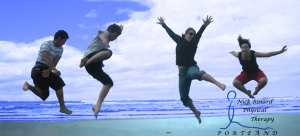 FREE CONSULTATION COUPON
FREE CONSULTATION COUPON
MENTION THIS COUPON AND SCHEDULE YOUR
FREE SCREEN TODAY
(503) 244-6232
In just 5-10 minutes, MDT can determine if your pain is mechanical or not. If so, we can help get you out of pain and back to enjoying your life.
Sweet (and Healthy) Chocolates for your Valentine…Or Yourself!
 Just use your favorite Valentine-shaped cookie cutters to make these treats!
Just use your favorite Valentine-shaped cookie cutters to make these treats!
- 1 1/2 cup walnuts
- 8 Medjool dates (these are softer than other dates, and easier to blend)
- 1/2 cup cocoa (use less if you don’t love dark chocolate)
Blend walnuts in a high powered blender or food processor until a powder. Pit the dates, then add walnut powder to a bowl and the pitted dates. Using your hands mix the two ingredients together until the dates are completely incorporated. Add the cocoa. Shape into a mold. Top with dried fruit, coconut, granola, or peanut butter!
Enjoy!
Want more fun and healthy recipes? See more here: http://www.superhealthykids.com/
More
LOW BACK PAIN—What you should do while waiting for your first physical therapy appointment…
SITTING:
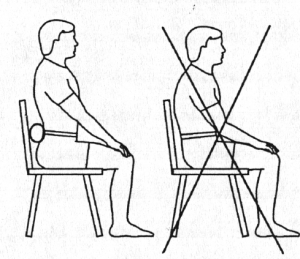 Sit as little as possible. Standing or lying down are preferable to sitting when in acute low back pain. If you must sit, sit only in a straight backed chair with good posture. Avoid couches or soft chairs. Use a towel roll to support the natural curve of your spine.
Sit as little as possible. Standing or lying down are preferable to sitting when in acute low back pain. If you must sit, sit only in a straight backed chair with good posture. Avoid couches or soft chairs. Use a towel roll to support the natural curve of your spine.
BENDING:
Do not bend forwards as in touching your toes when in acute low back pain—even if it feels like you are doing good by “stretching” the muscles of the low back. Rather than reaching down to get things, squat down using the legs and keep the back absolutely straight.
LYING:
Try to lie more on your stomach rather than on your back. Avoid the temptation to lie on your back with the head and knees propped up—this just rounds the back more and places inappropriate stress on injured structures.
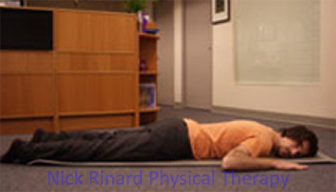
EXERCISES:
You should stay normally active–in other words try not to stay in bed for long periods. Move around, take walk if you can. Do not do the knees to chest exercise you may have learned before. This is an advanced exercise and usually not appropriate for acute conditions. It is better in most cases to lie on your stomach and work towards supporting yourself on the elbows.
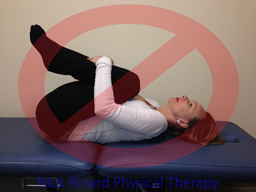 |
 |
| NO! |
YES! |
More
 “Should I get an x-ray or MRI before physical therapy?” This is a common question, and the answer is – NO. Why not? I hope to clarify that in this article, and give you a convincing reason to try physical therapy first.
“Should I get an x-ray or MRI before physical therapy?” This is a common question, and the answer is – NO. Why not? I hope to clarify that in this article, and give you a convincing reason to try physical therapy first.
 The American Heart Association recommends at least 30 minutes of moderate-intensity aerobic activity at least 5 days/week. In the pursuit of good health and fitness, many people are using YouTube to access new workouts. Unfortunately, there is neither quality control nor an accreditation process to ensure that the workouts are sound. Further complicating things is the “no pain, no gain” exercise myth which leads people to expect suffering with exercise. If someone expects exercising to be painful, they may not heed the early warning signs of pain and become injured.
The American Heart Association recommends at least 30 minutes of moderate-intensity aerobic activity at least 5 days/week. In the pursuit of good health and fitness, many people are using YouTube to access new workouts. Unfortunately, there is neither quality control nor an accreditation process to ensure that the workouts are sound. Further complicating things is the “no pain, no gain” exercise myth which leads people to expect suffering with exercise. If someone expects exercising to be painful, they may not heed the early warning signs of pain and become injured.

 What can you do?
What can you do?






